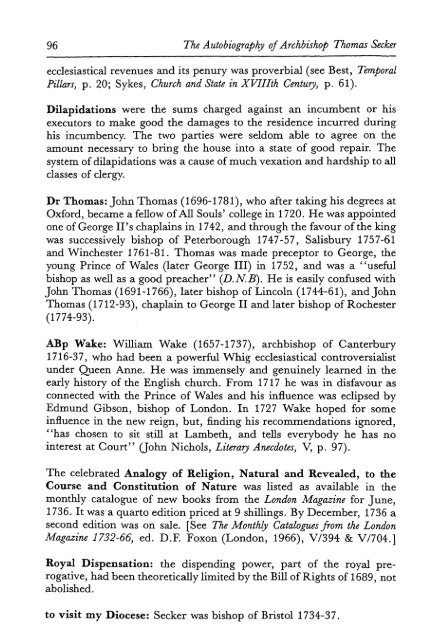Archbishop of Canterbury - KU ScholarWorks - The University of ...
Archbishop of Canterbury - KU ScholarWorks - The University of ...
Archbishop of Canterbury - KU ScholarWorks - The University of ...
You also want an ePaper? Increase the reach of your titles
YUMPU automatically turns print PDFs into web optimized ePapers that Google loves.
96<br />
<strong>The</strong> Autobiography <strong>of</strong> <strong>Archbishop</strong> Thomas Seeker<br />
ecclesiastical revenues and its penury was proverbial (see Best, Temporal<br />
Pillars, p. 20; Sykes, Church and State in XVIIIth Century, p. 61).<br />
Dilapidations were the sums charged against an incumbent or his<br />
executors to make good the damages to the residence incurred during<br />
his incumbency. <strong>The</strong> two parties were seldom able to agree on the<br />
amount necessary to bring the house into a state <strong>of</strong> good repair. <strong>The</strong><br />
system <strong>of</strong> dilapidations was a cause <strong>of</strong> much vexation and hardship to all<br />
classes <strong>of</strong> clergy.<br />
Dr Thomas: John Thomas (1696-1781), who after taking his degrees at<br />
Oxford, became a fellow <strong>of</strong> All Souls' college in 1720. He was appointed<br />
one <strong>of</strong> George II's chaplains in 1742, and through the favour <strong>of</strong> the king<br />
was successively bishop <strong>of</strong> Peterborough 1747-57, Salisbury 1757-61<br />
and Winchester 1761-81. Thomas was made preceptor to George, the<br />
young Prince <strong>of</strong> Wales (later George III) in 1752, and was a "useful<br />
bishop as well as a good preacher" (D.N.B). He is easily confused with<br />
John Thomas (1691-1766), later bishop <strong>of</strong> Lincoln (1744-61), and John<br />
Thomas (1712-93), chaplain to George II and later bishop <strong>of</strong> Rochester<br />
(1774-93).<br />
ABp Wake: William Wake (1657-1737), archbishop <strong>of</strong> <strong>Canterbury</strong><br />
1716-37, who had been a powerful Whig ecclesiastical controversialist<br />
under Queen Anne. He was immensely and genuinely learned in the<br />
early history <strong>of</strong> the English church. From 1717 he was in disfavour as<br />
connected with the Prince <strong>of</strong> Wales and his influence was eclipsed by<br />
Edmund Gibson, bishop <strong>of</strong> London. In 1727 Wake hoped for some<br />
influence in the new reign, but, finding his recommendations ignored,<br />
"has chosen to sit still at Lambeth, and tells everybody he has no<br />
interest at Court" (John Nichols, Literary Anecdotes, V, p. 97).<br />
<strong>The</strong> celebrated Analogy <strong>of</strong> Religion, Natural and Revealed, to the<br />
Course and Constitution <strong>of</strong> Nature was listed as available in the<br />
monthly catalogue <strong>of</strong> new books from the London Magazine for June,<br />
1736. It was a quarto edition priced at 9 shillings. By December, 1736 a<br />
second edition was on sale. [See <strong>The</strong> Monthly Catalogues from the London<br />
Magazine 1732-66, ed. D.F. Foxon (London, 1966), V/394 & V/704.]<br />
Royal Dispensation: the dispending power, part <strong>of</strong> the royal prerogative,<br />
had been theoretically limited by the Bill <strong>of</strong> Rights <strong>of</strong> 1689, not<br />
abolished.<br />
to visit my Diocese: Seeker was bishop <strong>of</strong> Bristol 1734-37.

















